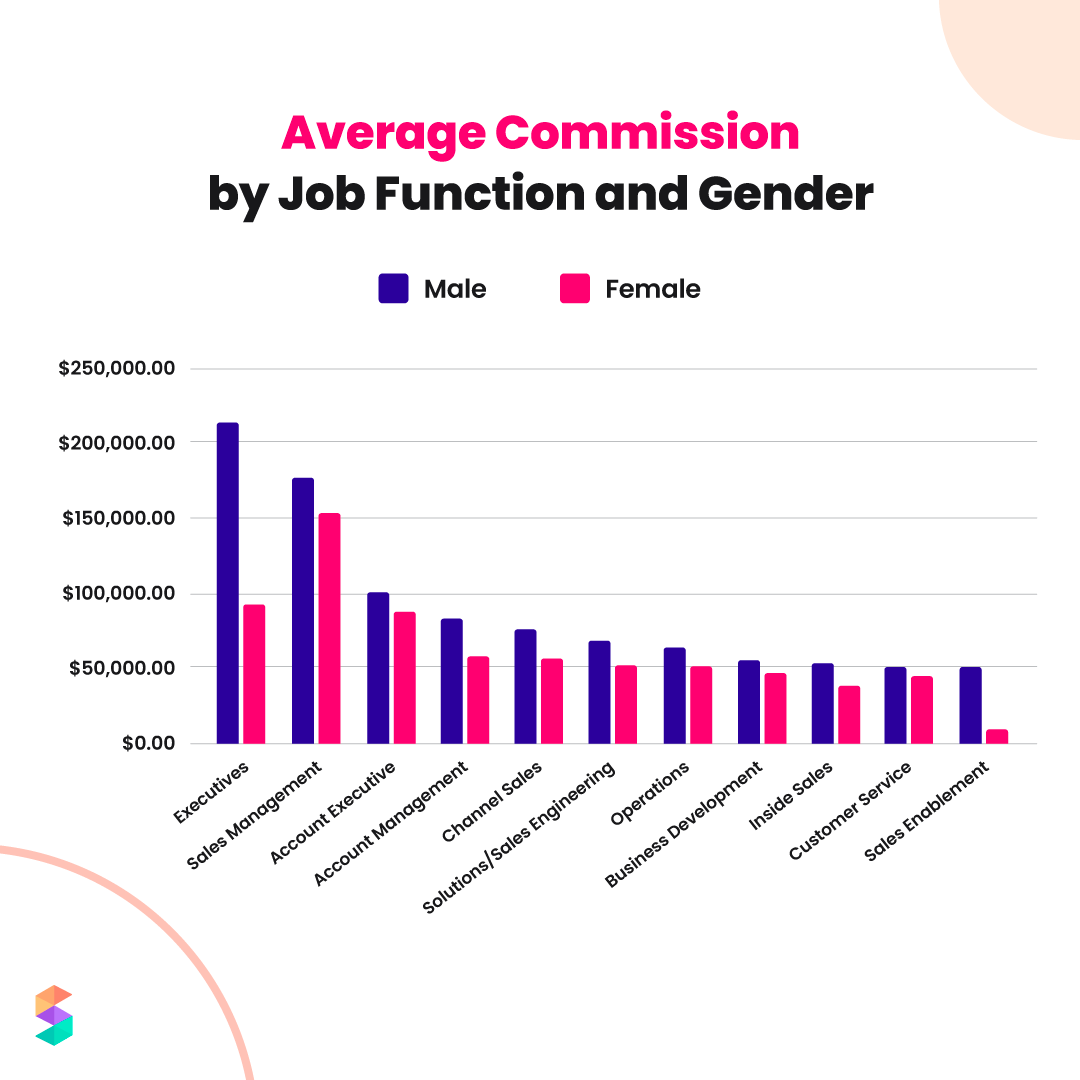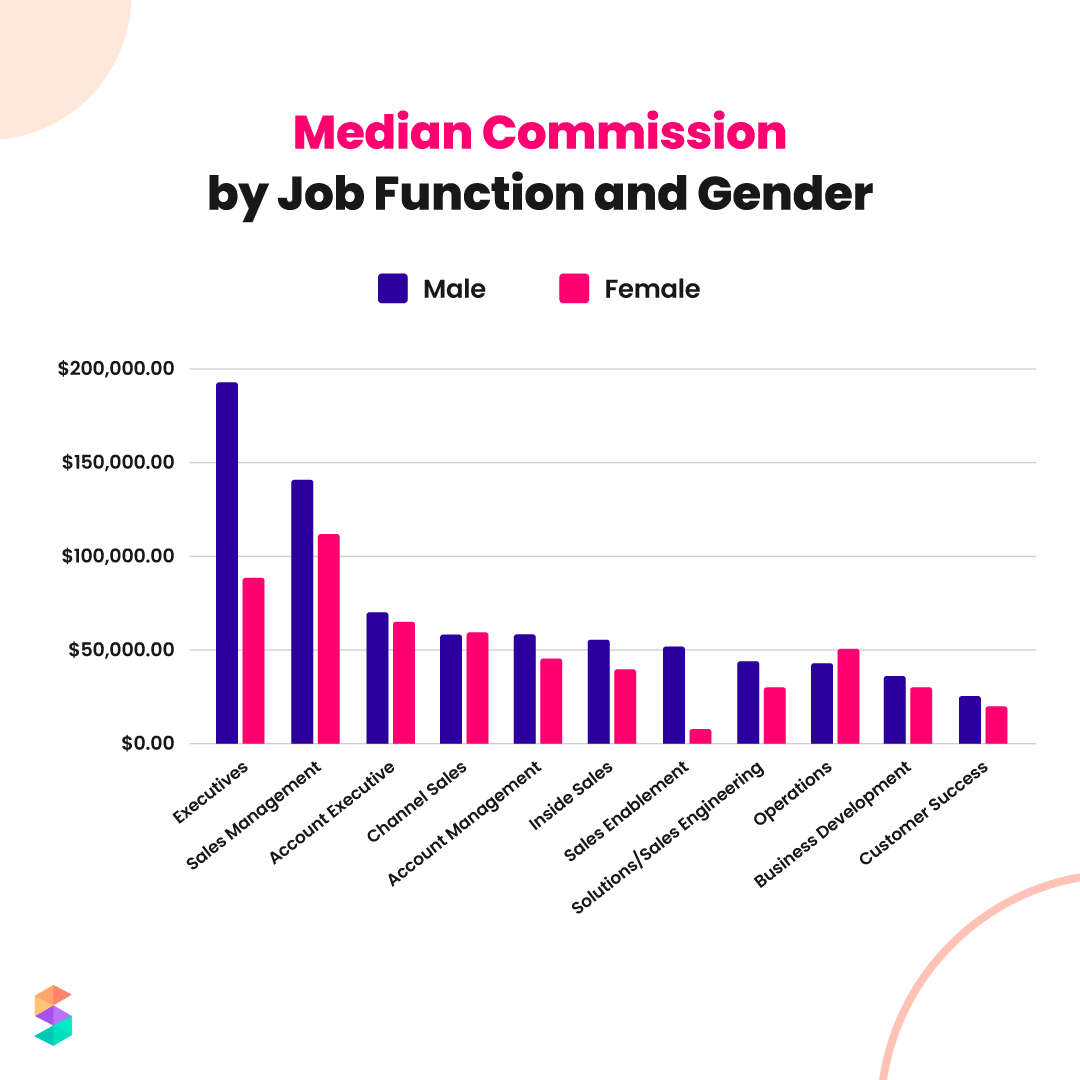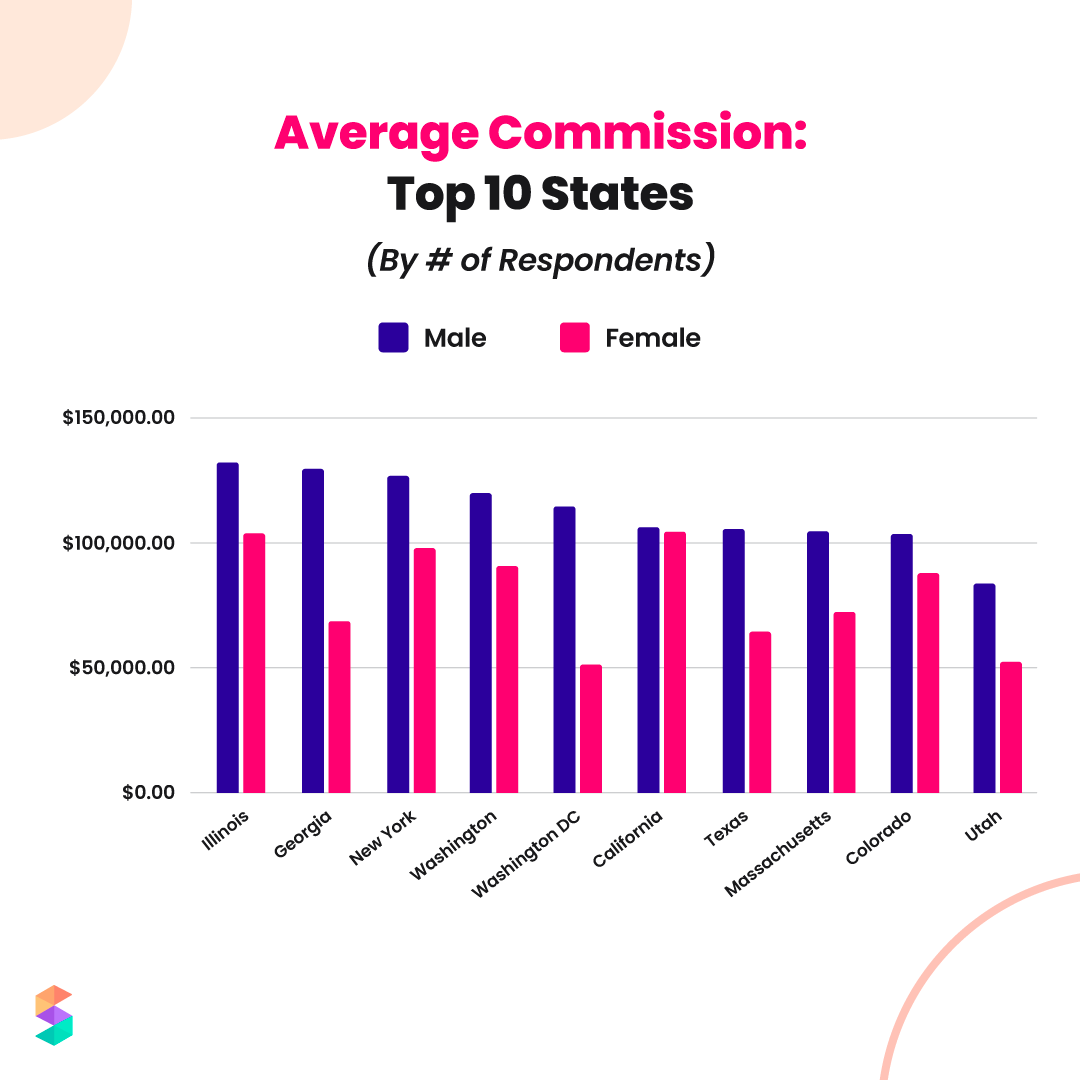Welcome back to our Sell Like a Girl series– where we’ve spent recent weeks unpacking gender bias in sales. Today we’re continuing this conversation by sharing a preview of our latest research on sales commission. We break down commission payouts across gender, job function, and location within the United States.
While the data we uncovered is concerning, it’s not surprising. Our findings are consistent with research done by countless institutions before us and highlights a severe and persistent problem. The uncomfortable truth is that women earn less sales commission than their male counterparts across all commissionable job functions and locations within the United States.
Today we unveil some of our findings and attempt to unravel what this data means. Let’s get into it.
The Current State of Gender Bias in Sales
Before we take a look at our newest findings, let’s level-set. Sales commission and salary aside, gender imbalance is a pervasive problem across many industries and occupations.
Although simply having a higher percentage of males or females doesn’t make an industry problematic, issues arise when systemic and societal obstacles prevent women from accessing and excelling in male-dominated spaces. Therefore, gender imbalance and gender bias often go hand in hand.
Sales, specifically, has a long history of being a male-dominated profession due to underlying gender bias. As a result, organizations often fail to support, protect, and nurture women in sales. This experience ultimately discourages other women from seeking out sales roles, thus perpetuating a vicious cycle. Consider these statistics:
- In 2022, Sales was ranked as the occupation with the tenth highest wage gap between men and women– with women earning $.91 to every $1 earned by men in equal roles with equal qualifications (source).
- Although women make up just over half of the college educated workforce, they hold less than one third of B2B sales jobs (source).
- Sexual harassment was listed in the top five most prevalent challenges faced by women in revenue roles in 2022– with even higher rates reported for Hispanic/Latina women, Native American women, and Black women in particular (source)
Despite the challenges women face securing, maintaining, and growing in a sales career, research shows that, when given the opportunity, women regularly outperform men. In fact, 77% of female B2B sales professionals met or exceeded last year’s sales targets, compared to 63% of their male colleagues who did the same (source).
A Deep Dive Into Inequity in Sales Compensation
In order to better understand the impact of gender on sales commission, we analyzed the annual commission data of 1,500+ commission-earning employees from 150+ companies, 43 states, 11 job functions, and 35+ industries.
28% of the data we analyzed belonged to female employees and 72% of the data belonged to male employees– this is relatively consistent with other data we found around the gender makeup of typical sales organizations.
We looked exclusively at variable pay. These findings purposely do not include base salary.
Below is a preview of our findings.
Recommended reading: 29 Critical Sales Compensation Benchmarks & Statistics
Average Commission by Job Function and Gender
- Across all commissionable roles, men, on average, earn 26% more annual sales commission than their female counterparts.
- Male C-Level Executives were found to earn, on average, 130% more annual commission than female C-Level Executives– making this segment the largest average commission pay gap across all job functions.
- Male AEs earn, on average, 15% more annual commission than female AEs– making this segment the smallest average commission pay gap across all job functions.

Median Commission by Job Function and Gender
- When we look at the median values across all commissionable job functions, that number does not change significantly– with the median annual commission earned by men 26.5% higher than the median commission earned by women.
- The median amount of sales commission earned by men in Sales Enablement roles was 485% higher than the median amount of sales commission earned by women in Sales Enablement roles– making this segment the largest median commission pay gap across all job functions.
- The median amount of sales commission earned by men in Channel Sales roles is actually 1% less than the median amount of sales commission earned by women in Channel Sales roles– making this segment the most evenly matched median commission earnings across job functions.
- The median amount of sales commission earned by men in Sales Operations roles is actually 22% less than the median amount of sales commission earned by women in Sales Operations roles- making this segment the only job function where women earn significantly more sales commission than men. Although, we will note that Sales Operations was among the smaller functions represented in our research with 14 men and only 2 women. It’s likely that a larger sample would paint a different picture.

Max Commission by Job Function and Gender
- When we look at the max amount of annual commission a man can earn across job functions, it’s 36% higher than the max amount of commission a woman can earn across job functions.
- The max amount of sales commission a male C-Level Executive can earn is 323% higher than the max amount of sales commission a female C-Level Executive can earn– making this segment the largest max commission pay gap across job functions.
- Worth noting is that the female max earnable commission is about half of the male average commission for C-Level Executives– meaning men earn, on average, double the max amount of sales commission a female C-Level executive will ever earn.
- The max amount of commission a man in Customer Success can earn annually is 5% more than the max amount of commission a woman in Customer Success can earn annually– making this segment the job function with the smallest max commission pay gap across job functions.

Average Commission by Location and Gender
- An employee’s location within the US doesn’t have a massive impact on wage gap numbers with one notable exception– In CA, men and women earn, on average, nearly the same amount of sales commission annually.
- On the other side of the spectrum, the worst location in terms of average commission gap is Washington D.C– Men in Washington DC earn 121% more sales commission, on average, than women in Washington DC.

The Sales Commission Gap vs. The Salary Gap
Typically in discussions about wage gaps and gender biases, the discussion starts and ends with salary negotiations, promotability, and growth opportunities. But, because this particular data set only looks at variable pay, it forces us to think beyond the surface level reasons why women in sales are earning less than men.
Because, if we pretend women and men are paid the same base salary and put on identical commission plans (which we readily admit is not always the case), women have the same opportunity to earn as much as men, right? After all, sales commission is a direct reflection of effort and performance, right?
Wrong.
Performance is Not The Problem
As we referenced earlier in this article, men aren’t outperforming women in a way that might explain the gap we see in commission pay. So, what gives? Why do we see such marked pay inequalities despite comparable (often, superior) sales performance from women?
While we may not have all of the answers, our upcoming research report will unpack the unconscious gender bias and discrimination women face on sales teams. For now, we leave you with a condensed version of our findings.
Here are several factors that reinforce compensation inequities and prevent sales teams from achieving true gender diversity:
The Motherhood Penalty
Research shows that when women become mothers, employers see them as less valuable and less employable than not only men, but also less employable than women who don’t have children. This is known as the motherhood penalty. Consider these facts (source):
- Mothers are 6x less likely than childless women and 3x less likely than childless men to be recommended for hire.
- Childless women are 8.2x more likely to be recommended for a promotion than mothers. And, childless women were found to be twice as likely to receive second round interviews than women with children.
- Mothers are offered starting salaries that are 8% lower than non-mothers and 9% lower than fathers.
Here’s the kicker, though, when men become fathers there’s increasing evidence of a fatherhood bonus– meaning, when men become fathers their perceived value, and therefore their earnings, actually increase.
The motherhood penalty ultimately results in lower pay, less opportunity to move into leadership roles, and overall less favorable treatment of mothers compared to their male counterparts or women without children.
This penalty is particularly harsh in male-dominated industries like sales, where there is a pervasive culture of long hours, inflexible schedules, and lack of support for work-life balance, making it more difficult for mothers to juggle their professional and personal responsibilities.
Recommended reading: The Advice These Women in Sales Wish They’d Been Given Sooner
The Boys Club
The boys club refers to a social phenomenon that happens frequently in male-dominated professions. It’s typically something seen among male colleagues who share interests, backgrounds, and values thus making it difficult for women and other underrepresented groups to join their ranks or access the same opportunities and benefits.
A stereotypical example of this type of environment might involve important networking opportunities or career conversations happening during informal golf outings or drinks after work– events women aren’t invited to or feel uncomfortable attending. These activities and behaviors can create a culture that reinforce behaviors that negatively impact women in the workplace.
In most cases, the existence of a boys’ club mentality is often apparent to women. However, women don’t always realize the extent to which they are being discriminated against or excluded from professional opportunities. Boys’ clubs often thrive in a culture of secrecy, operating and making decisions behind closed doors.
Research shows that one in three women report that they’ve missed out on professional opportunities because important conversations took place during out-of-office activities (source). This suggests that access to critical information and opportunities may be limited to those who are part of the boys’ club network, leaving women at a disadvantage.
Recommended reading: How to Run a More Diverse and Inclusive Hiring Experience
Lack of Representation
A lack of gender diversity on sales teams can perpetuate and feed into the harmful ideals and stereotypes that often prevent women from pursuing sales careers in the first place. Without women in sales management positions to advocate for and champion the next generation of sellers, it can be difficult for women to break into sales roles and advance in their careers.
The shift organizations have made in recent years to attract and retain more diverse teams isn’t simply because it’s the right thing to do. Research has proven time and again that teams with equal parts men and women are more successful financially. Consider these statistics:
- McKinsey & Company’s report “Diversity Wins” found that companies in the top quartile for gender diversity on their executive teams were 25% more likely to have above-average profitability than companies in the bottom quartile. These same companies were less likely to have employee turnover rates (source).
- A study by Boston Consulting Group found that companies with above-average diversity on their management teams had higher innovation revenue, with 19 percentage points higher revenue from innovation compared to companies with below-average diversity (source)
- A report by the Harvard Business Review found that companies with diverse teams are 45% more likely to report growth in market share over the previous year and 70% more likely to capture a new market (source)
- Female sales leaders only make up 26% of sales leadership, yet studies show that teams led by women often perform better than their male-led counterparts (source).
Although creating safe spaces for women to succeed shouldn’t require financial incentive, the research above proves there are no valid reasons for businesses to ignore, allow, or encourage environments that aren’t conducive to the success of all genders and backgrounds.
Recommended reading: Using a Sales Leaderboard to Motivate Your Team
The Broken Rung
The “broken rung” is a phenomenon that describes the difficulty women face in advancing from entry-level positions to managerial roles in male-dominated professions, including sales.
According to research done by McKinsey & Company in 2021, women continue to face a “broken rung” between entry-level/individual contributor roles up to the manager level. Here is what McKinsey found (source):
- For every 100 men promoted to manager, only 86 women are promoted. As a result, men significantly outnumber women at the manager level, which means there are far fewer women to promote to higher levels, creating a domino effect.
- And, although female representation has increased since 2016, these gains in representation for women overall do not translate to gains for women of color.
- Women of color continue to lose ground at every step in the pipeline—between the entry level and the C-suite, the representation of women of color drops off by more than 75 percent.
- As a result, women of color account for only 4 percent of C-suite leaders, a number that hasn’t moved significantly in the past three years.
This lack of upward mobility can be attributed to several factors, including bias and stereotyping, a lack of sponsorship and mentorship, and a dearth of female role models in leadership positions.
Recommended reading: Creating Compensation Plans for Sales Engineers
Only Syndrome
The women who do move into leadership roles often find their day-to-day experience only worsens as they climb higher up the professional ladder. Compared to entry-level women, women in leadership positions are more than twice as likely to say they have only syndrome– a phenomenon that happens when a woman is the only woman or one of a few women in male-dominated professional spaces (source).
This can refer to being the only woman on a sales leadership team, the only woman at the C-Level of an organization, or the only female member of high level boards or committees.
Unfortunately, women in this situation are more likely than men to face microaggressions that undermine or challenge their competence– something that only increases as they gain seniority.
Recommended reading: Building Your First SDR Commission Plan
Final Thoughts
Women across industries and job functions continue to earn less money than their male counterparts in identical roles, for identical contributions. This is a problem that disproportionately impacts women in male-dominated roles like sales.
Although change can (and should) start by evaluating your compensation plans and rectifying discrepancies that lead male sellers to earn more than female sellers, these issues go far beyond comp planning.
In the next few weeks we will continue this conversation and plan to share the comprehensive research we conducted around gender and sales commission– some of which we featured in today’s article. Come back soon for additional insights, actionable steps you can take to create safer more supportive spaces for women, and so much more!
We can’t wait to share this project with you!
Recommended reading: A Manager’s Guide to Communicating Compensation Changes to Employees
A Note About This Series
We want to take a second to point out that, although this series focuses on the experiences of women in sales, we understand that steps need to be taken to foster safe, diverse, and healthy environments for everyone. We also recognize that female minorities in particular face bias, harassment, and discrimination at disproportionately high rates compared to the averages seen in this article.
The last point we want to make is that we recognize that much of the widely available data on gender in the workplace, and in sales specifically, isn’t inclusive of individuals who fall outside the gender binary. As more data becomes available, we hope to paint a more complete and inclusive picture of sales as a profession.






